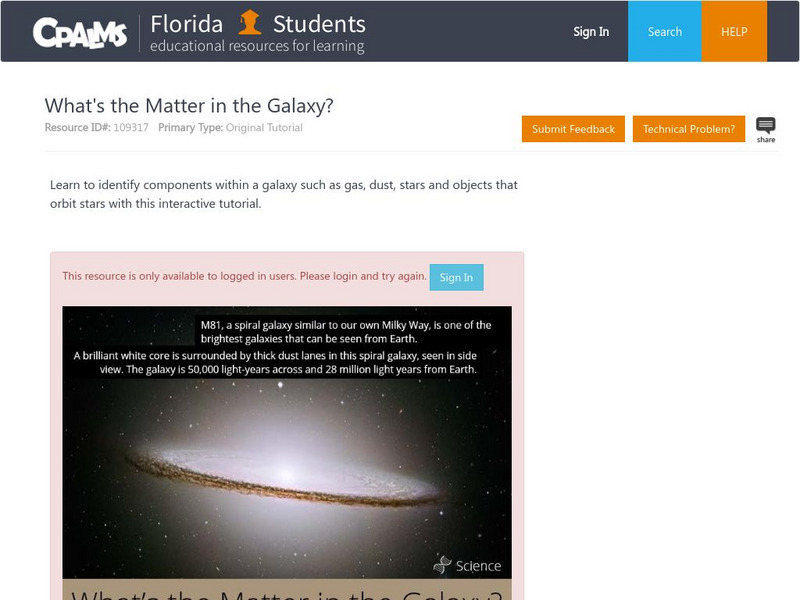Curated OER
Astronomy
In this astronomy instructional activity, students read a detailed text about our solar system. Students then answer 15 questions about the information presented.
Curated OER
What is a black hole anyway?
In this black holes worksheet, students answer multiple choice questions about black holes in space. Students complete 4 multiple choice questions.
Curated OER
Solar System Multiple Choice Activity
In this solar system worksheet, students complete a ten question multiple choice page pertaining to the solar system. Prior knowledge is assumed.
Curated OER
Solar System Vocabulary 2
In this solar system instructional activity, students write vocabulary words describing the solar system next to their definitions. Students write 12 vocabulary words.
Curated OER
Space Math Differentiation-"Ch..Ch..Ch..Changes"
In this differentiation in space math worksheet, students use 6 different equations to solve 6 problems that involve differentiation related to astrophysics.
Curated OER
Solar System Crossword 2
In this solar system activity, students fill in a crossword that gives them clues about the solar system. Students solve 41 clues for the crossword.
Curated OER
Knowledge Quiz: The Universe
In this universe quiz worksheet, students complete a set of 10 multiple choice questions that cover a variety of concepts about the universe: constellations, black holes, the solar system, etc.
Curated OER
The Universe-Scientific Notation Extension
In this scientific notation worksheet, students write a set of 9 average distances in standard form, then complete 3 additional problems. A reference web site is given for additional activities.
Curated OER
Into The Universe
In this space science worksheet, students find the solution to find the different heavenly objects through identifying the pictures.
Curated OER
The Solar System
In this solar system word puzzle instructional activity, learners use the 17 clues regarding the solar system to fill in the blanks in the crossword puzzle.
Curated OER
Solar System Crossword
In this solar system instructional activity, students fill in a crossword that gives them clues about the solar system. Students solve 31 clues for the crossword.
Curated OER
Science: Space Quiz
In this science: space quiz worksheet, students answer twenty questions, not interactively, about outer space, then scroll down to find the answers.
Curated OER
Observing the Outer Planets
Students observe the outer planets. In this science lesson, students use a telescope locate the outer planets of the solar system. Students create a video of their observations.
Curated OER
The Solar System
In this crossword puzzle instructional activity, students read the 20 clues about the solar system. Students then complete the puzzle with 20 words related to the solar system.
Curated OER
Astronomical Scales
Young scholars describe the different units of measurement. In this space science lesson, students calculate astronomical distances using a scale. They explain the significance of using scientific notation in expressing very small...
Curated OER
Color Recognition
Students envision how space observatories make use of monochromatic filters to collect data on the color of objects in space. They see the actual colors of objects when they are in monochromatic light.
University of Wisconsin
University of Wisconsin: The Constellations and Their Stars
An excellent site dedicated to the constellations and information about the objects which make them up. Contains a great deal of information about various stars, galaxies and other objects, as well as details on how best to observe them.
Science Buddies
Science Buddies: The Milky Way and Beyond: Globular Clusters
Globular clusters, compact groups of about a million stars that move around together in galaxies, are among the oldest objects found in the universe. Since they are found most galaxies and since they've been around for so long, globular...
TED Talks
Ted: Ted Ed: Dark Matter: How Does It Explain a Star's Speed?
Video describes how stars move in a spiral galaxy and how their speeds can be explained by accounting for dark matter. [3:17] Includes a brief quiz and a list of additional resources to explore.
Globio
Glossopedia: Stars
Many of the objects you can see in the night sky are stars, large objects in space that produce light. Our galaxy, the Milky Way, contains more than 100 billion stars. Stars are so far away that their light does not reach us for years....
CPALMS
Florida State University Cpalms: Florida Students: What's the Matter in the Galaxy?
A tutorial that looks at the components within a galaxy such as gas, dust, stars and objects that orbit stars. A PDF file of the tutorial is available.
Google
Google Earth: Hubble Telescope
Get a tour of space with images collected from the Hubble telescope. See nebulae, galaxies, and star clusters on this site. Google Earth must be downloaded to use.
Science Buddies
Science Buddies: The Moon and the Stars
When you are in the city, only a few of the brightest stars are visible. But when you are in the country, you can see many more stars than you can count. Sometimes you can even see the bright belt of our galaxy, the Milky Way. In this...
Other
University of Leicester: Spiral Galaxies
Provides a general overview of spiral galaxies, including descriptions of the different classes of spiral galaxy.























